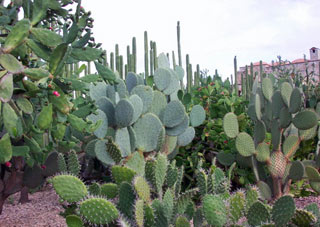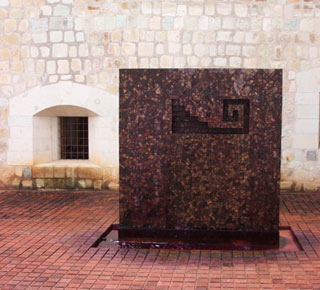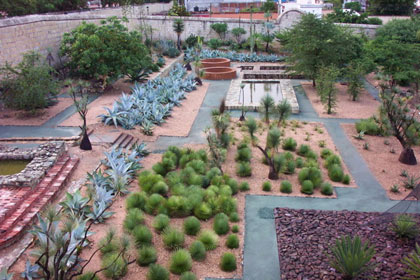Human Flower Project
Monday, June 18, 2007
Jardín Etnobotanico de Oaxaca – Welcoming
Horticulturist, author, and landscape designer Jill Nokes has seen (and created) garden marvels across the world. Today she beckons us to a personal favorite in Oaxaca, Mexico, where cultural history reaches right out of the ground. We eagerly await Jill’s Yard Art and Handmade Places, due out in October. Mil gracias, Jill!

Some of the varieties of nopal bred by Native Mexicans
for food and cochineal production
Photo: Jill Nokes
By Jill Nokes
My friends in Oaxaca City tell me that things are slowly but steadily recovering from last summer’s chaotic political demonstrations. Although that sad, destructive ordeal was but a blip on the region’s long and complex history, I grieved for a city where so many livelihoods depend on tourism.
And I still worry about how those disastrous events may have affected the most amazing and profound garden I have ever seen: the Jardín Etnobotanico de Oaxaca (The Ethnobotanical Garden of Oaxaca).
Housed within the massive walled complex of the sixteenth century ex-convento Santo Domingo, this garden was designed by artists Luis Zarate and Francisco Toledo and ethnobiologist Alejandro de Avila. They sought to build not just a decorative garden but a plant collection that would tell the story of Oaxaca and its people. The founders’ hope was to celebrate the relationship between people and plants in their state and magnify the message of the cultural museum now housed in the enclosing cloister.
 Francisco Toledo’s sculpture in the entry courtyard
Francisco Toledo’s sculpture in the entry courtyard
Photo: Jill Nokes
This is a particularly rich story to tell, as Oaxaca, home to sixteen ethnic groups, has the greatest political and ethnic diversity in Mexico. Its geologic complexity has resulted in an exceptionally high rate of endemism and biological diversity. Here you find more species of cycads, plumerias, and oaks than anywhere else in the world. Oaxaca also contains every kind of ecotone that exists in the world: from deserts to cloud forests, from beaches to temperate woodlands. Current research has revealed that Oaxaca was where corn was first domesticated, and the wealth of colonial Oaxaca came from the sophisticated selection and breeding of the cochineal (a scale insect) and nopal (prickly pear), both actions which show the interdependence of plant and people. Though the contrast of plants, gravel, and sky is stunningly beautiful, the message the jardin hopes to impart is that there is a direct connection between ethnic diversity and biodiversity.
At the entrance, you are greeted with water, and you follow the water as you make your way through the garden. Opposite the gate resides a sculpture made from four huge pieces of mica-clad Monteczuma cypress or ahuehuete (Taxodium mucronatum). Mica, a mineral laminate, was used as a decorative cover on the floors of elite residences in the ancient city of Teotihuacan, and may have served ritual purposes as well. The cypress was associated with sacred ancestor gods. Within the sculpture is carved the “step-fret” zig-zag design, which some scholars believe refers to both Ehecatl, the wind god, and the nose of Cocijo, the god of rain.
Water dyed red with cochineal drips over the cypress block, symbolizing the source of the city’s wealth. It also signifies precious water commingled with the blood of the Indians, those who died after the Conquest and while laboring over 100 years to build the vast convent. Farther down the narrow courtyard looms the graceful beauty of the huaje tree (Leucaena esculenta), from which the city derives its name. The familiar name of the tree comes from the way its pods resemble the glossy dark red pods of the chile guajillo.
In the courtyard, there are fewer than five plants, but meanings and messages many times that number. In the main garden, there are a thousand plants and counting.

View of the garden’s “xeric” side from the ex-convento/regional museum
Photo: Jill Nokes
Last year’s fracaso, which kept many travelers from visiting Oaxaca, has subsided. My Mexican friends there say it’s safe and peaceful now—all is well. And visitors would be appreciated, even more than usual. Thanks to Alejandro Avila, founding director, for providing important details to this story. He reports that members of the original team who created the Jardín Etnobotanico are back on hand to welcome travelers, scholars, and lovers of beauty, all who hope to learn more about this special place, its plants and its people.




